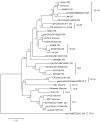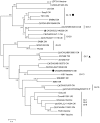Infectious Bronchitis Virus Variants: Molecular Analysis and Pathogenicity Investigation
- PMID: 28937583
- PMCID: PMC5666712
- DOI: 10.3390/ijms18102030
Infectious Bronchitis Virus Variants: Molecular Analysis and Pathogenicity Investigation
Abstract
Infectious bronchitis virus (IBV) variants constantly emerge and pose economic threats to poultry farms worldwide. Numerous studies on the molecular and pathogenic characterization of IBV variants have been performed between 2007 and 2017, which we have reviewed herein. We noted that viral genetic mutations and recombination events commonly gave rise to distinct IBV genotypes, serotypes and pathotypes. In addition to characterizing the S1 genes, full viral genomic sequencing, comprehensive antigenicity, and pathogenicity studies on emerging variants have advanced our understanding of IBV infections, which is valuable for developing countermeasures against IBV field outbreaks. This review of IBV variants provides practical value for understanding their phylogenetic relationships and epidemiology from both regional and worldwide viewpoints.
Keywords: antigenicity; genotypes; infectious bronchitis virus; pathogenicity; variants.
Conflict of interest statement
The authors declare no conflicts of interest.
Figures


Similar articles
-
Molecular characterization and pathogenicity of infectious bronchitis coronaviruses: complicated evolution and epidemiology in china caused by cocirculation of multiple types of infectious bronchitis coronaviruses.Intervirology. 2009;52(4):223-34. doi: 10.1159/000227134. Epub 2009 Jul 3. Intervirology. 2009. PMID: 19590226
-
Complete genome sequences of two avian infectious bronchitis viruses isolated in Egypt: Evidence for genetic drift and genetic recombination in the circulating viruses.Infect Genet Evol. 2017 Sep;53:7-14. doi: 10.1016/j.meegid.2017.05.006. Epub 2017 May 8. Infect Genet Evol. 2017. PMID: 28495648
-
Identification of an infectious bronchitis coronavirus strain exhibiting a classical genotype but altered antigenicity, pathogenicity, and innate immunity profile.Sci Rep. 2016 Nov 23;6:37725. doi: 10.1038/srep37725. Sci Rep. 2016. PMID: 27876864 Free PMC article.
-
Current situation, genetic relationship and control measures of infectious bronchitis virus variants circulating in African regions.J Basic Appl Zool. 2016 Aug;76:20-30. doi: 10.1016/j.jobaz.2016.08.002. Epub 2016 Nov 20. J Basic Appl Zool. 2016. PMID: 32288944 Free PMC article. Review.
-
Review of infectious bronchitis virus around the world.Avian Dis. 2012 Dec;56(4):634-41. doi: 10.1637/10227-043012-Review.1. Avian Dis. 2012. PMID: 23397833 Review.
Cited by
-
First detection of D181 genotype of infectious bronchitis in poultry flocks of Morocco.Virol J. 2024 Oct 28;21(1):267. doi: 10.1186/s12985-024-02539-z. Virol J. 2024. PMID: 39468571 Free PMC article.
-
Detection and Molecular Characterization of GI-1 and GI-23 Avian Infectious Bronchitis Virus in Broilers Indicate the Emergence of New Genotypes in Bolivia.Viruses. 2024 Sep 14;16(9):1463. doi: 10.3390/v16091463. Viruses. 2024. PMID: 39339939 Free PMC article.
-
Avian Infectious Bronchitis Virus: Molecular Detection in Southwestern Ethiopia Chickens.Int J Microbiol. 2024 Sep 14;2024:6979448. doi: 10.1155/2024/6979448. eCollection 2024. Int J Microbiol. 2024. PMID: 39310377 Free PMC article.
-
Immuno-pathogenesis study of local infectious bronchitis virus G1-1 lineage variant showed altered tissue tropism in experimental broiler chickens.Vet Res Commun. 2024 Sep 2. doi: 10.1007/s11259-024-10525-7. Online ahead of print. Vet Res Commun. 2024. PMID: 39222200
-
Potential Transcriptional Enhancers in Coronaviruses: From Infectious Bronchitis Virus to SARS-CoV-2.Int J Mol Sci. 2024 Jul 23;25(15):8012. doi: 10.3390/ijms25158012. Int J Mol Sci. 2024. PMID: 39125583 Free PMC article.
References
-
- Schalk A., Hawn M. An apparently new respiratory disease of baby chicks. J. Am. Vet. Med. Assoc. 1931;78:413–422.
-
- Promkuntod N., Van Eijndhoven R., De Vrieze G., Gröne A., Verheije M. Mapping of the receptor-binding domain and amino acids critical for attachment in the spike protein of avian coronavirus infectious bronchitis virus. Virology. 2014;448:26–32. doi: 10.1016/j.virol.2013.09.018. - DOI - PMC - PubMed
Publication types
MeSH terms
LinkOut - more resources
Full Text Sources
Other Literature Sources

